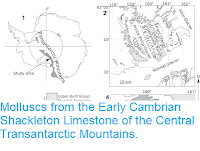Mussels, Mytilidae, are a large, and highly successful group of Bivalve Molluscs found from the coastal shorelines to the deep ocean. They are particularly prominent cooler waters, where they form vast banks in shallow waters, making them a major shaper of the environment. Mussels are noteworthy for the production of a byssus, a thread by which they attach themselves to the substrate.
In a paper published in the European Journal of Taxonomy on 24 September 2019, Kurt Ockelmann of the Marine Biological Laboratory at the University of Copenhagen, and Tomas Cedhagen of the Section of Aquatic Biology at Aarhus University, describe a new species of Mussel from the Kattegat-Skagerrak Staraight, the body of water that separates Denmark from Scandinavia and the North Sea from the Baltic.
The new species is placed in the genus Modiolus, and given the specific name cimbricus, in reference to the ancient Cimbrican people of northern Jutland. The species is described from a population previously known, but assigned to Modiolus adriaticus, a warm-water species no longer thought to be found this far north. The species has colourful asymmetric shells which can reach about 25 mm in length, although this size is seldom reached, with the Mussels becoming sexually mature after a year, when they are 4-6 mm in length.
Modiolus cimbricus typically lives enwrapped in a ball of its own byssus threads, studded with particles of sand and other material. This is probably a defence against Starfish, voracious marine predators which are specialist Mussel-eaters, pulling their shells open by modifying their tube feet to form suction disks, then inserting their stomachs through the gaps to digest the Mussels. Attaching material to the outside of the shell is known to make such attacks harder, so the extensive covering of Modiolus cimbricus should be a good defence.
Modiolus cimbricus is one of a high number of endemic species (species found nowhere else) known from the Baltic, Kattegat and Skagerrak regions. All endemic species and populations in the Baltic Sea must have evolved after the Weichselian Glaciation, between 115 000 and 11 700 years ago, when the Baltic was covered by an ice sheet. Speciation in the region can be very fast, for example the Brown Alga Fucus radicans evolved during the last four hundred years. Most marine species are unable to survive in the brackish water of the Baltic, enabling populations that find a way to survive to rapidly radiate into new niches.
Ockelmann and Cedhagen consider it highly likely that Modiolus cimbricus has evolved since the Weichselian Glaciation from a founder population of Modiolus adriaticus. The latter species forms part of a Mediterranean-centred population that reaches as far north as the English Channel and Irish Sea, where warm waters from the Gulf Stream circulate, but cut off from the Kattegat by the colder, Arctic-influenced waters of the North Sea. However, occasionally the autumn sees warm water packages from the Bay of Biscay move up the English Channel and into the southern North Sea, and one of these could conceivably have carried the ancestors of Modiolus cimbricus to the Kattegat.
See also...
The new species is placed in the genus Modiolus, and given the specific name cimbricus, in reference to the ancient Cimbrican people of northern Jutland. The species is described from a population previously known, but assigned to Modiolus adriaticus, a warm-water species no longer thought to be found this far north. The species has colourful asymmetric shells which can reach about 25 mm in length, although this size is seldom reached, with the Mussels becoming sexually mature after a year, when they are 4-6 mm in length.
Modiolus cimbricus, shell length 13.3 mm. The upper part of the fi gure shows the external shell side and the lower part shows the inner side of the valves. Scale bars are 5 mm. Ockelmann & Cedhagen (2019).
Modiolus cimbricus typically lives enwrapped in a ball of its own byssus threads, studded with particles of sand and other material. This is probably a defence against Starfish, voracious marine predators which are specialist Mussel-eaters, pulling their shells open by modifying their tube feet to form suction disks, then inserting their stomachs through the gaps to digest the Mussels. Attaching material to the outside of the shell is known to make such attacks harder, so the extensive covering of Modiolus cimbricus should be a good defence.
Modiolus cimbricus. A 17.5 mm long specimen in its ball of sand grains. This specimen has been cultured for fi ve years. Scale bar is 5 mm. Ockelmann & Cedhagen (2019).
Modiolus cimbricus is one of a high number of endemic species (species found nowhere else) known from the Baltic, Kattegat and Skagerrak regions. All endemic species and populations in the Baltic Sea must have evolved after the Weichselian Glaciation, between 115 000 and 11 700 years ago, when the Baltic was covered by an ice sheet. Speciation in the region can be very fast, for example the Brown Alga Fucus radicans evolved during the last four hundred years. Most marine species are unable to survive in the brackish water of the Baltic, enabling populations that find a way to survive to rapidly radiate into new niches.
Ockelmann and Cedhagen consider it highly likely that Modiolus cimbricus has evolved since the Weichselian Glaciation from a founder population of Modiolus adriaticus. The latter species forms part of a Mediterranean-centred population that reaches as far north as the English Channel and Irish Sea, where warm waters from the Gulf Stream circulate, but cut off from the Kattegat by the colder, Arctic-influenced waters of the North Sea. However, occasionally the autumn sees warm water packages from the Bay of Biscay move up the English Channel and into the southern North Sea, and one of these could conceivably have carried the ancestors of Modiolus cimbricus to the Kattegat.
See also...
Follow Sciency Thoughts on Facebook.








